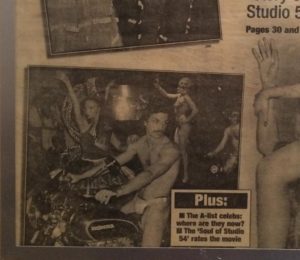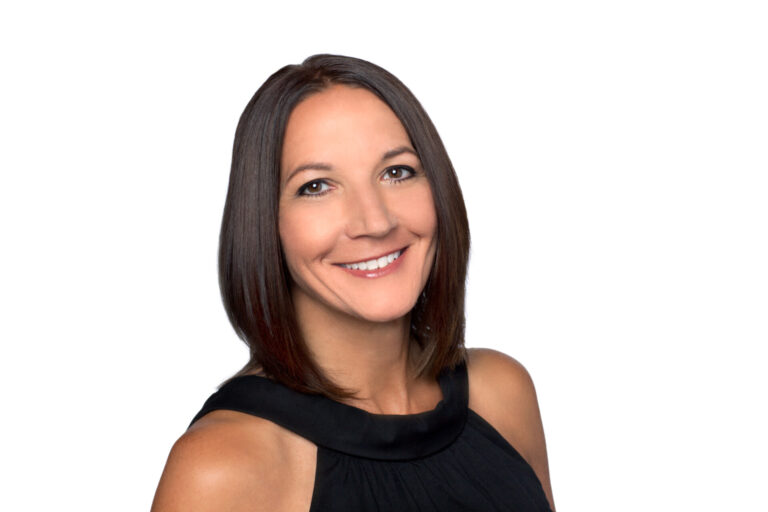“We did not walk to the club in our g-strings,” Murray Tanner clarifies. “Once we got to the club, we changed into them back stage.”
After donning the silver thongs–and little else–Murray and seven other scantily clad men mounted the motorcycles they’d been loaned for the evening. Murray had ridden a motorcycle once before in his life–earlier that day at rehearsal. “Just don’t get out of first gear,” someone had told him. “Easy enough…I hope,” Murray thought.

Murray, pictured far right, at the opening night party of Studio 54
Once Murray had mounted his bike, a topless dancer perched herself on the backseat. She was one of eight dancers performing that night–one for each of the drivers. When everyone was in position, the men revved the bikes and drove them out onto the dance floor. Murray was immediately struck by the lights, which, rumor had it, had cost a million dollars. They flashed and pulsed to the blaring music and illuminated the several hundred people circling the floor. Most of them were high, and, therefore, delighted. The crowd cheered at the spectacle before them. Motorcycles in a nightclub? Who’d ever seen such a thing!
The drivers did a few figure eights, careful not to run into one another or any of the drug-addled onlookers, and parked. The dancers dismounted and began their performance. After they finished shimmying and shaking to the whoops and whistles from their audience, they climbed back on the cycles. Murray and his fellow drivers spun the bikes around the floor two more times and drove off stage.
“We did the show that opened Studio 54,” Murray says. “And that’s my one claim to fame.”
Get the Gravity newsletter for the latest FAQs, tools, tips and tricks
It was April 26, 1977, a few hours into the grand opening of what would become New York City’s most iconic and infamous disco. Although it was well past midnight and he’d already performed two shows earlier that night, the then twenty-one-year-old Murray was full of energy. He was doing the thing he loved most: entertaining people. “You go on stage, suddenly the lights are there, the noise is there, the people are there, the music is there, and let’s just say your adrenaline starts to flow.”

Murray performing a comedy routine as part of the cast of “Pouff”
New York in the seventies was synonymous with sex, drugs, crime, and all manner of debauchery that would be inappropriate to discuss here. No place better encapsulated that culture than Studio 54. It’s a far cry from the life Murray leads now. Today, Gravity’s senior risk analyst is more likely to be found on the golf course than at the dance club. But, back when he was an aspiring actor trying to make it big in the Big Apple, partying all night with little regard for the consequences–physically, financially, legally–was pretty much his way of life.
Growing up in suburban New Jersey, Murray caught the acting bug his senior year of high school. “I was a lazy SOB,” he says, “and I only needed to pass English to get to graduate. So, I took as many easy courses as I could, and one of them was speech and drama. Now, of course when you do speech and drama you put on shows, and I found I had some kind of ability at it, and I liked it. Then I decided that’s what I want to be when I grow up.”
The summer after he graduated, he moved to New Hampshire to participate in Summer Stock, a seasonal performance program in which volunteers put on different shows for vacationers. After the season ended, Murray moved to New York where he hoped to make it big in show business. “The goal was to become famous,” he says.
Unfortunately, well-paying acting gigs were not as easy to come by as he’d imagined, so he ended up taking a job at Chase Manhattan Bank to pay the bills. He got a job working weekends at a children’s theater and took every opportunity possible to seek new acting work. He’d take extra-long lunch breaks to make it to auditions and often show up to work late and/or hungover from partying with other actors the night before. Not surprisingly, his managers at Chase didn’t look too favorably on these activities, and after a year and a half, he was asked to leave.
When the job at Chase ended, Murray took on a series of jobs–cab driver, warehouse picker–to help him make ends meet while he tried to make his acting dreams a reality. He continued to perform in children’s theater, both as a performer and as a lighting and sound technician, going on auditions, and doing showcases throughout the year.
In early 1977, Murray finally landed a regular gig in a show called Pouff at La Vie en Rose night club on 56th Street. He got the job after working as an understudy and doing light and sound at a similar show for the same producers at the Playboy Club, first in Chicago and then New York. Pouff was a Parisian-style revue show complete with topless dancing girls, comedy bits, men in drag, and various song and dance numbers. It was raunchy and campy and extremely popular. When Murray joined the ensemble, Pouff had been running for three straight years and the cast performed two shows every weeknight and three shows on weekends.
A few months after Murray joined the cast, Pouff was invited to perform at the Studio 54 opening-night party. Although there was a lot of buzz about the new venue and a guest list studded with A-list celebrities, no one imagined they were witnessing history the night of the opening. In fact, Murray remembers that the club wasn’t serving alcohol that night after being raided by the state liquor authority and assumed that was a portent of doom. “Most of us were like, ‘They’re going to be lucky if they last a week,’ Murray says. “Shows you what we know.”
As payment for their performance that night, the cast of Pouff was granted unlimited free admission to the club, so Murray ended up returning many times after that first night. “Two, three, sometimes four times a week we would go hangout at Studio 54 after the shows were done,” he says. “At that time in New York City if I wanted to indulge in carnal activities, all I had to do was find a girl that wanted to go to Studio 54, and I was home free.”
Murray can’t share a lot of the stories from his nights at Studio 54, either because he doesn’t remember them or because they’re too explicit to disclose on the website of a credit-card processing company. One thing he does remember is the feeling of entering the club. “The club itself was outrageous,” he says. “The lobby was extraordinarily ornate. In fact, I was recently watching a documentary on 54, and they showed the lobby, and I’d actually forgotten just how ornate the lobby was. And from coming in the front door, that hit you right away and you could hear and see through the one door the lights flashing, you could hear the music going, and you could feel the thump, thump, thump of the bass. So before you even got inside the club and on the dance floor, you could feel the excitement.”
Perhaps the quality that made Studio 54 most famous was its air of exclusivity and glamor. Countless celebrities passed through its doors during the club’s heyday–from David Bowie to Dolly Parton to Donald Trump. Murray himself recalls seeing Liza Minelli, Rick James, Andy Warhol, and many other celebrities during his visits there. “Who didn’t you see in those days?” he says. “Anybody that was famous came there.
Unfortunately, his arms-length encounters with these personalities were the closest Murray himself would ever get to fame. At the end of 1977, La Vie en Rose shut down and Murray lost his regular gig in Pouff. Although he continued to take on showcase work for a few years after that, he stopped performing for good in 1982. “At that time I really wasn’t cut out for what it took to have a chance to succeed,” he says. “I would have just had a lot of disappointment and who knows what trouble I would have found?”
Reflecting on his decade as a performer, Murray remembers the time with fondness, not regret. “It signifies a point in time in my life where I was pretty much completely carefree and living the life that I wanted to lead by going into show business in the first place,” he says. “And it verified my thinking that show business was one big whirlwind party, having a good time and enjoying oneself, and, you know, tomorrow come what may.”
Written by Brooke Carey, Lead Storyteller
Humans of Gravity is a profile series designed to highlight the unique individuals who comprise our team. Gravity Payments believes in celebrating our shared humanity by letting employees bring their full selves to work. Interested in joining this amazing group of people? Check out our Careers page for the latest opportunities.



